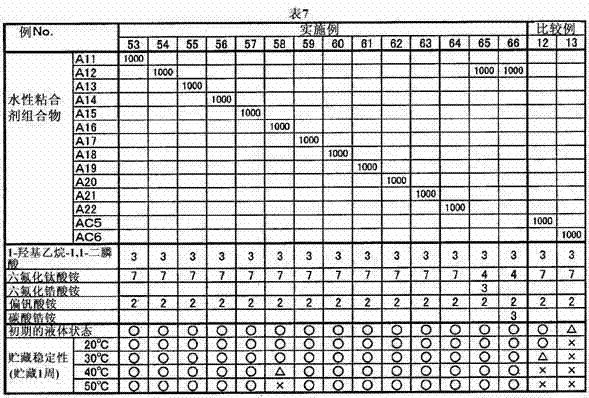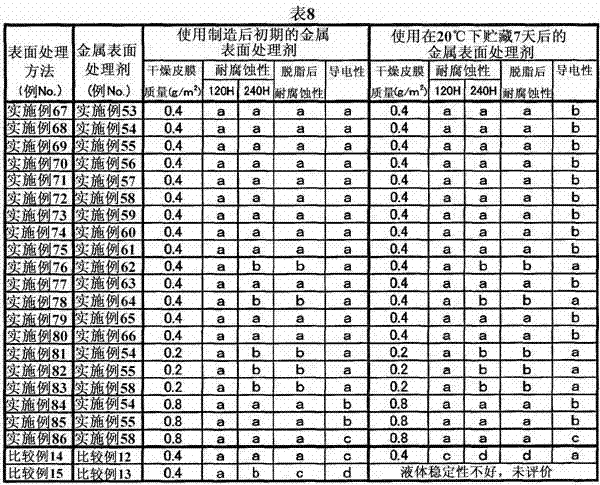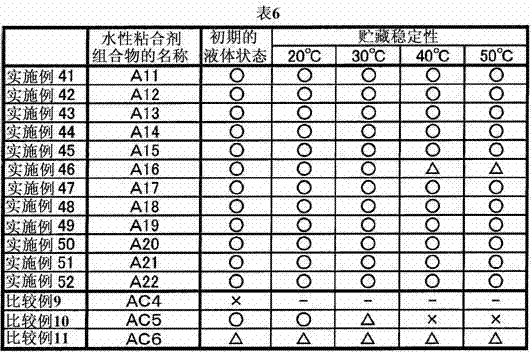Aqueous binder composition for metal surface treatment agents
A metal surface treatment, water-based adhesive technology, applied in the direction of metal material coating process, coating, primer, etc., can solve the problems of insufficient liquid stability and electrical conductivity, and achieve excellent liquid stability and tight adhesion. Excellent properties and conductivity, coatability and liquid stability
- Summary
- Abstract
- Description
- Claims
- Application Information
AI Technical Summary
Problems solved by technology
Method used
Image
Examples
Embodiment 1
[0160] 57 parts of N-2-(aminoethyl)-3-aminopropyltrimethoxysilane was added to a separable flask equipped with a reflux condenser, a thermometer and a stirrer, and γ- 61 parts of glycidoxypropyl trimethoxysilane. Exothermic heat was generated due to the dropwise addition, but the temperature was kept at 40°C or lower. After the dropwise addition was completed, the mixture was aged with stirring, naturally cooled for 1 hour, and then heated and reacted at 80°C for 5 hours. From the results of 1H-NMR measurement, it was confirmed that no epoxy group remained in the content after the reaction. Next, 28 parts of acetic acid and 1000 parts of deionized water were added and stirred for 30 minutes to dissolve the contents after the reaction, thereby obtaining an aqueous solution of a silane reaction product (A'). The neutralization equivalent of the silane reaction product (A') with acetic acid was 0.9.
[0161] To the aqueous solution of the silane reaction product (A'), 6 parts o...
Embodiment 2
[0164] In a separable flask equipped with a reflux condenser, a thermometer, and a stirrer, 1,000 parts of deionized water was added, and N-2-(aminoethyl)-3-aminopropyltrimethoxysilane was slowly added while cooling with an ice bath. 57 parts to dissolve. Next, 12 parts of acetic acid was added to the contents, 61 parts of γ-glycidyloxypropyltrimethoxysilane was added, stirred for 30 minutes to dissolve, and then heated and reacted at 80° C. for 5 hours to obtain a silane reaction product (A') aqueous solution. From the 1H-NMR measurement result, it was confirmed that no epoxy group remained in the silane reaction product (A'). The neutralization equivalent of the silane reaction product (A') with acetic acid was 0.4.
[0165] Next, 6 parts of an 89% phosphoric acid aqueous solution was mixed with the aqueous solution of the silane reaction product (A'), stirred for 30 minutes, and dissolved by adding 250 parts of deionized water, followed by distillation under reduced press...
Embodiment 3
[0168] In a separable flask equipped with a reflux condenser, a thermometer and a stirrer, 1,000 parts of deionized water and 19 parts of acetic acid were added, and 61 parts of γ-glycidoxypropyltrimethoxysilane was slowly added while stirring, and the mixture was stirred for 10 minutes. to dissolve. Next, 57 parts of N-2-(aminoethyl)-3-aminopropyltrimethoxysilane was slowly added thereto, stirred for 30 minutes to dissolve, and then heated and reacted at 80° C. for 5 hours to obtain a silane reaction Aqueous liquid of product (A'). From the 1H-NMR measurement result, it was confirmed that no epoxy group remained in the silane reaction product (A'). The neutralization equivalent of the silane reaction product (A') with acetic acid was 0.6.
[0169] To the aqueous solution of the silane reaction product (A') was mixed 6 parts of an 89% phosphoric acid aqueous solution, stirred for 30 minutes, added 250 parts of deionized water to dissolve it, and concentrated by distillation ...
PUM
| Property | Measurement | Unit |
|---|---|---|
| Flash point | aaaaa | aaaaa |
| Flash point | aaaaa | aaaaa |
Abstract
Description
Claims
Application Information
 Login to View More
Login to View More - R&D
- Intellectual Property
- Life Sciences
- Materials
- Tech Scout
- Unparalleled Data Quality
- Higher Quality Content
- 60% Fewer Hallucinations
Browse by: Latest US Patents, China's latest patents, Technical Efficacy Thesaurus, Application Domain, Technology Topic, Popular Technical Reports.
© 2025 PatSnap. All rights reserved.Legal|Privacy policy|Modern Slavery Act Transparency Statement|Sitemap|About US| Contact US: help@patsnap.com



